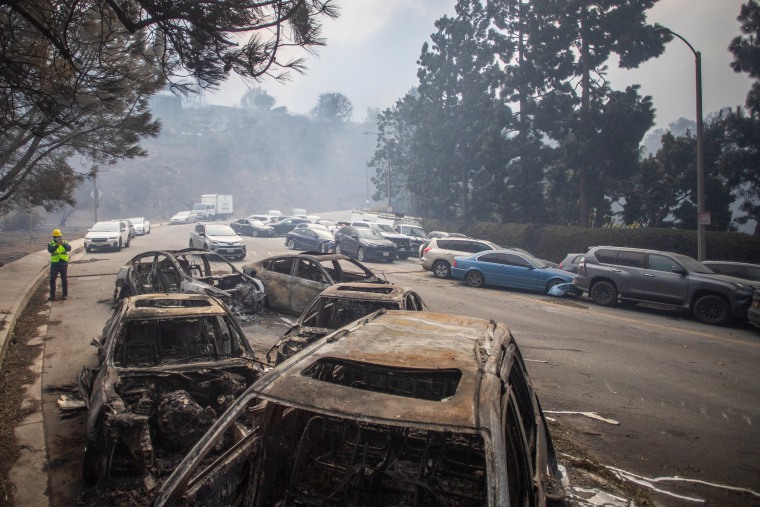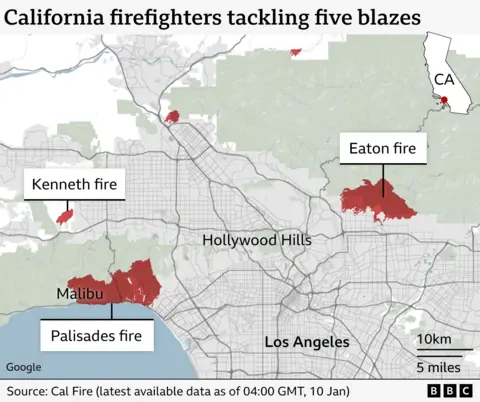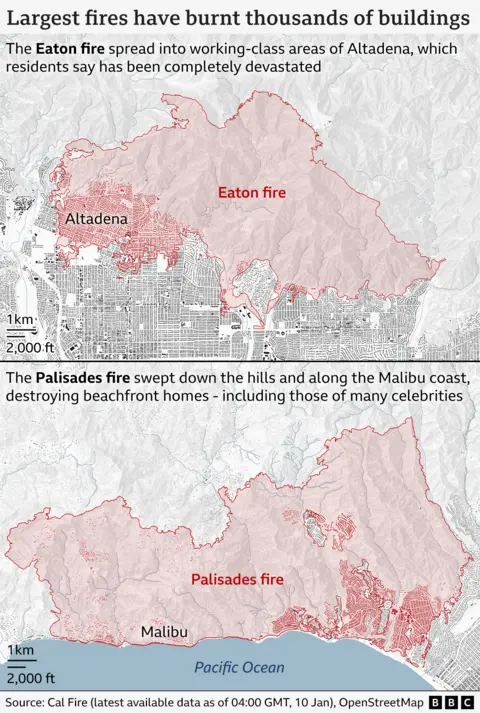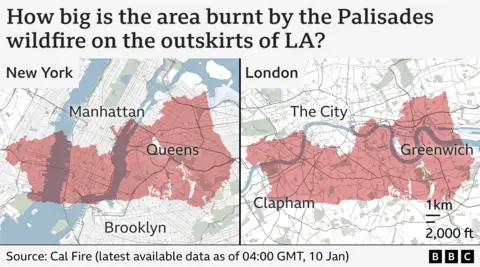What’s the latest on the Los Angeles wildfires and what caused them?


Out-of-control wildfires are ripping across parts of Los Angeles, leading to at least 10 deaths, burning down hundreds of buildings, and prompting evacuation orders for thousands of residents across the county.
Despite the efforts of thousands of firefighters, the biggest blazes remain mostly or totally uncontained – with weather conditions and the underlying impact of climate change expected to continue fanning the flames for days to come.
What’s the latest?
(For real time containment and fire statuses , you can go here.)
In LA county, some 153,000 people are under evacuation orders as of Friday morning. Many of them fled their homes with just the belongings they could carry.
Another 166,000 residents are under evacuation warning, meaning they may need to leave their homes soon.
More than 10,000 buildings have been razed by the fires, which are the most destructive in the history of LA. A further 60,000 are also at risk. Insured losses are expected to be above $8bn (£6.5bn) because of the high value of properties in the paths of the blazes.
A man was arrested on Thursday afternoon after residents suspected that he was attempting to start a new fire. Police said he was charged with a probation violation but that there was not enough probable cause to charge him with arson, and an investigation continues.
The causes of the original fires are not yet known.
National Guard troops have been deployed in some parts of the city to prevent looting in evacuated areas, and there have been 20 arrests, according to police
Where are the fires?

There are at least five fires raging in the wider area, according to California fire officials:
- Palisades: The first fire to erupt on Tuesday and the biggest in the region, which could become the most destructive fire in state history. It has scorched a sizable part of land, covering more than 20,000 acres, including the upmarket Pacific Palisades neighbourhood. It was 8% contained as of Friday morning
- Eaton: It has struck the northern part of Los Angeles, blazing through cities such as Altadena. It’s the second biggest fire in the area, burning nearly 14,000 acres. It is 3% contained
- Hurst: Located just north of San Fernando, it began burning on Tuesday night and has grown to 771 acres, though firefighters are beginning to contain it
- Lidia: It broke out on Wednesday afternoon in the mountainous Acton area north of Los Angeles and grew to cover almost 350 acres. Authorities say it has been 60% contained
- Kenneth: This new fire broke out on Thursday on the border of Los Angeles and Ventura counties. It so far covers nearly 1,000 acres. Authorities said its progress has been stopped and it has been 35% contained, with no structures damaged or destroyed
The earlier Sunset, Woodley and Olivas fires have been contained.
Was LA prepared for the fires?

A political row about the city’s preparedness has erupted after it was claimed that some firefighters’ hoses ran dry, provoking criticism from US President-elect Donald Trump.
Los Angeles County Fire Chief Anthony Marrone said during a Thursday news conference that he had not received reports that firefighters ran out of water or experienced low water pressures.
But in neighbouring Pasadena, Fire Chief Chad Augustin said the area experienced a short period of time where pressure was low on a small amount of hydrants. All issues had been resolved, he said.
He attributed the issue to multiple fire engines drawing water at the same time, as well as a loss of power lowering pressure.
Mayor Karen Bass returned to the city from a previously arranged trip to Ghana to find it on fire. She has faced intense questions about the region’s preparedness, her leadership in this crisis, and the water issues.
And before the fires broke out, LA’s fire chief warned in a memo that budget cuts were hampering the department’s ability to respond to emergencies, the BBC’s US partner CBS News reports.
Dismay over the fire threat was worsened by an alert that was mistakenly sent to every mobile phone in Los Angeles on Thursday, residents say, prompting anger from some. About 10 million people live in the county.
During a news conference Friday morning, city authorities said they were investigating why the mass alert was sent out, and urged people not to disable the alert function on their phones, which they said was vital to provide up-to-the-minute emergency information.
What caused the fires?
A combination of an exceptionally dry period – downtown Los Angeles has only received 0.16 inches (0.4cm) of rain since October – and powerful offshore gusts known as the Santa Ana winds have created ripe conditions for wildfires.
Santa Ana winds flow east to west through southern California’s mountains, according to the National Weather Service.
The winds can also be responsible for the scale of destruction that follows.
Blowing across the deserts further inland, they create conditions where humidity drops, which dries out vegetation. If a fire does start, the winds can fan smouldering embers into an inferno in minutes.
Speeds of 60 to 80mph (95-130km/h) are common, but gusts of up to 100mph (160km/h) can occur.
Although the strongest wind gusts have passed through the region, forecasters have warned another “traditional Santa Ana wind event” will move in on Thursday night local time, according to CBS News.
Investigations into what initially sparked the fires are continuing.
LA District Attorney Nathan Hochman said that the focus of law enforcement is currently on saving lives and homes and assisting firefighters, but that eventually they would turn towards investigating the causes of the fires.
“If it is determined that there is a man-made and intentional setting of any of the fires involved in this situation, the people who committed this arson will be arrested, they will be prosecuted and they will be punished to the full extent of the law,” he said.
Hochman also warned people against looting, violating curfews in the affected areas and flying drones near the fires, and warned of scams targeting fire victims.
Arson is not the only cause of deadly wildfires. Power lines and other utility equipment have sparked some of the most destructive blazes in California’s history. In 2018, the so-called Camp Fire destroyed the town of Paradise and killed 85 people, many of whom died in their cars trying to flee.
There is a glimmer of hope for firefighters, as the fire weather outlook for southern California has been downgraded from “extremely critical” to “critical”.
But BBC weather forecaster Sarah Keith-Lucas says there is no rain forecast in the area for at least the next week, so conditions remain ripe for fire.
On Friday, authorities said they were gearing up for another high-wind “red flag” event, indicating dry and windy conditions, forecast for Monday.

What role has climate change played?
Although strong winds and lack of rain are driving the blazes, experts say climate change is altering the background conditions and increasing the likelihood of such fires.
Much of the western United States including California experienced a decades-long drought that ended just two years ago, making the region vulnerable.
“Whiplash” swings between dry and wet periods in recent years created a massive amount of tinder-dry vegetation that was ready to burn.
US government research is unequivocal in linking climate change to larger and more severe wildfires in the western US.
“Climate change, including increased heat, extended drought, and a thirsty atmosphere, has been a key driver in increasing the risk and extent of wildfires in the western United States,” the National Oceanic and Atmospheric Administration says.
Fire season in southern California is generally thought to stretch from May to October – but the state’s governor, Gavin Newsom, has pointed out earlier that blazes had become a perennial issue. “There’s no fire season,” he said. “It’s fire year.”

This article was originally written by James FitzGerald and Tom McArthur and appeared here.


Comment (0)